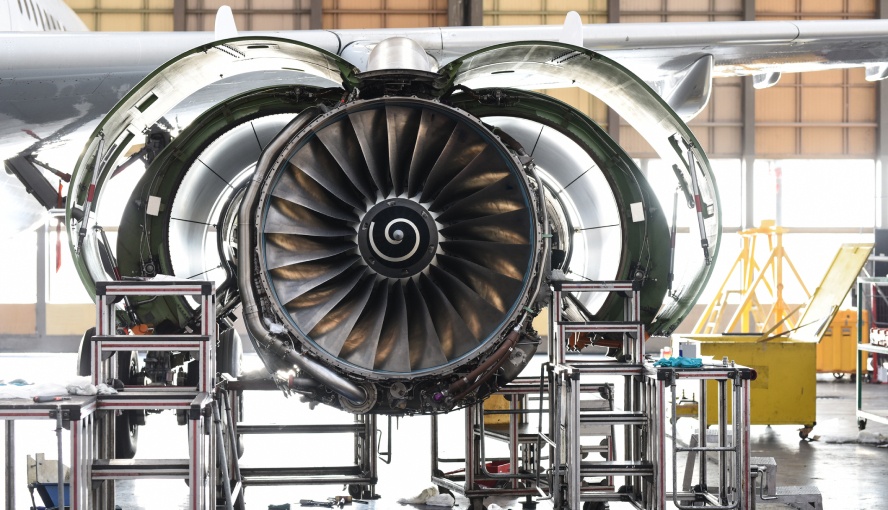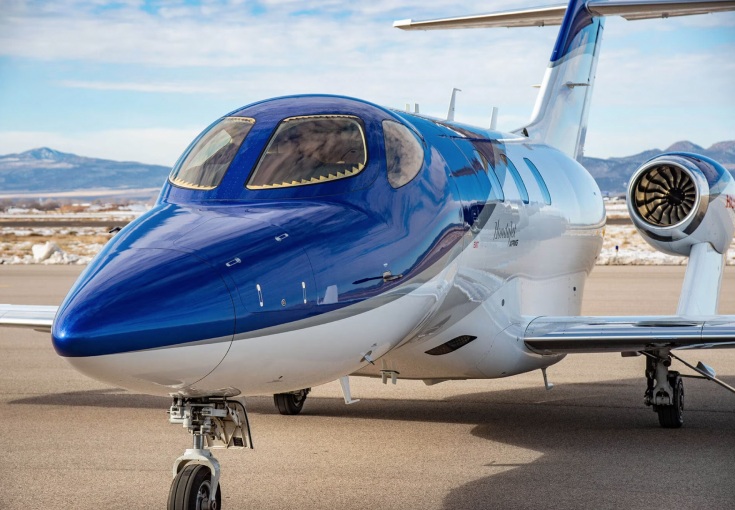What is the difference between a plane and a jet? If you are booking a business class ticket, chances are the type of aircraft won’t matter. But aircraft type does matter for those who are getting into ownership or looking for the fastest, most efficient charter.
From piston-engine to turboprop to jet, we explain the fundamental differences between all these aircraft types below. We go beyond the engine to examine speed, range, and efficiencies for planes vs. jets.
What is a plane?
For the purposes of this article, planes refer to any piston engine or turboprop aircraft. Piston engine planes rely on piston power, while turboprop aircraft rely on propeller power.
Both plane types are generally smaller, slower, and have a shorter range than jets. But, they are more fuel efficient for shorter, lower-altitude flights and are therefore widely used for short-haul flights, pilot and crew training, and recreational pilots.
A few of the largest manufacturers of these types of planes include Cessna, Beechcraft, and Piaggio, among others.
What is a jet (and a private jet)?
While all jets are airplanes, not every airplane is a jet. Jets require a jet engine to get the ‘jet’ designation.
A jet engine draws in air and compresses it with jet fuel. This mixture is then ignited in a controlled manner, creating a high-energy combustion that travels through the turbine, propelling the aircraft forward.
Although performance specifications vary widely depending on manufacturer and model, jets can generally fly faster and higher than non-jet-engine aircraft. These are just a few of the reasons why they are preferred for long-distance flights.
The world’s largest jet manufacturers include HondaJet, Gulfstream, Cessna, Embraer, Bombardier, and Boeing.
What about private jets?
Whether the jet has been adapted for commercial or private use, you can expect to see the same performance specs (speed, altitude, takeoff and landing requirements, etc.). For each make and model, you’ll find the same jet engine and avionics technology used for both the private and commercial versions.
The core differences between private vs. commercial jets are all found within the cabin. Instead of serving the general public and fitting a maximum number of people into each flight, private jets cater to small groups with an elevated interior setting, including entertainment areas, full lavatories, and working spaces.
Performance differences: Private jet vs. turboprop plane.

Speed
In broad terms, jets are faster than planes. Mechanically speaking, jet engines simply create more thrust than turboprop engines and, therefore, can fly at higher speeds.
Jet engines and turboprop engines use two different approaches to aircraft propulsion. Jets rely on the principle of jet propulsion, while turboprops use propeller propulsion. As speeds increase, approaching the speed of sound, propellers become less effective due to aerodynamic limitations, which caps the aircraft’s maximum speed.
The table below compares speeds of several of the most common turboprops and jets flying the skies today. Is a private jet faster than a plane? As you can see, even the smallest jet is over 100 KTAS faster than any turboprop engine plane.
| Aircraft Model | Passenger Capacity | Type | Speed (knots) |
|---|---|---|---|
| Beechcraft King Air 3501 | Up to 11 | Turboprop | 320 ktas |
| ATR 722 | Up to 78 | Turboprop | 270 ktas |
| Dash 8-Q4003 | Up to 90 | Turboprop | 360 ktas |
| Gulfstream G280 | Up to 10 | Jet | 482 ktas |
| Bombardier Global 55004 | Up to 19 | Jet | 600 ktas |
| Embraer E1755 | Up to 90 | Jet | 481 ktas |
Altitude
Jets also fly higher than other types of planes, thanks partly to their ability to reach higher speeds. While there are outliers with each aircraft type, jets normally maintain an average cruising altitude between 31,000 and 42,000 feet, while turboprop planes tap out at 30,000 feet.
If we compare the same aircraft models again, it’s easy to see that in a competition between planes vs. jets, jets soar above their turboprop counterparts.
| Aircraft Model | Passenger Capacity | Type | Altitude |
|---|---|---|---|
| Beechcraft King Air 3506 | Up to 11 | Turboprop | 35,000 ft |
| ATR 727 | Up to 78 | Turboprop | 25,000 ft |
| Dash 8-Q4008 | Up to 90 | Turboprop | 25,000 ft |
| Gulfstream G280 | Up to 10 | Jet | 41,000 ft |
| Bombardier Global 55009 | Up to 19 | Jet | 41,000 ft |
| Embraer E17510 | Up to 90 | Jet | 41,000 ft |
Fuel efficiency
Turboprop aircraft are measurably more fuel efficient than their similarly sized jet counterparts. By some assessments, turboprops maybe 10 to 60 percent more efficient. Yet, this assessment reverses for longer missions and higher altitudes, where jets become the more fuel-efficient option.
What is the tipping point between the two aircraft types? A jet becomes the more fuel-efficient option when it spends long enough at its cruising altitude to offset the inefficiencies of its takeoff and landing.
When most of the flight is spent ascending and then descending from cruising altitude, turboprops are the most efficient option simply because they are more efficient for takeoff and landings.
Flying by jet vs. flying turboprop: Key advantages.


While there are a lot of similarities between an airplane and a jet, each has a few core advantages depending on the type of mission.
| Jet Advantages | Turboprop Advantages | |
|---|---|---|
| Speed | Higher average cruising speeds, ideal for long-distance flights | Lower average cruising speeds, ideal for short-haul flights |
| Range | Longer range, ideal for international and long-haul flights | Suitable for shorter regional flights |
| Passenger Comfort | Generally smoother ride at high altitudes, less affected by weather; cabin often much quieter | Can be more comfortable on shorter flights due to lower cruising speed and altitude |
| Runway | Requires longer runways | Generally requires shorter runways |
| Fuel Efficiency | More fuel-efficient at high altitudes and speeds | More fuel-efficient on shorter, low-altitude routes |
Considerations when choosing private jet vs. private turboprop plane.

Safety records
Whether flying by jet or turboprop, always choose to work with charter operators who go above and beyond industry safety standards. At Volato™, we participate in ARGUS Platinum and IS-BAO Stage 3 safety programs, always fly with two pilots, and mandate that our pilots enjoy above-industry-standard rest periods. Before you fly, ask your operator what steps they are taking to ensure your safety.
Destination
Consider your final destination. While turboprop and piston planes may make sense for short-haul flights or those with short runways, jets will be the best option for longer, more comfortable flights. Plus, modern jets like the Gulfstream G280 are certified for steep approaches, short runways, and high-altitude airports.
Time efficiency
There is no argument that jets are significantly faster than both piston-engine and turboprop planes. If time is of the essence, a jet will get you where you need to go much more efficiently than any plane. This is especially true for long-haul flights, where many jets can hit cruising speeds nearing the speed of sound and do so without disturbing the comfort of their passengers.
Availability
If you are chartering a private flight anywhere within the continental United States, you’ll likely have several options. Especially around major cities and travel hubs, you’ll have your choice of private jet charters, turboprop charters, and helicopter charters.
But, this might not always be the case in other areas of the world, primarily rural and remote areas. As only one example, if you charter a flight in Alaska, you’ll almost certainly be on a turboprop plane.
FAQs
Is a private jet faster than a plane?
A jet is typically faster than a plane (turboprop or piston-powered). Jet engines are much more powerful, translating into much faster top cruising speeds. Even the latest turboprop planes, like the Evolution Turbine, only have a maximum cruising speed of 290 ktas. Compare that with a similarly sized HondaJet with a top speed of 422 ktas.
Why are jets better than planes?
Recreational pilots and aviation enthusiasts love piston and turboprop planes, but from the perspective of most passengers, jets provide a much better in-flight experience. Jets fly faster and farther than planes, and modern jet engines are significantly quieter than their propeller engine counterparts. Plus, jets can hit higher cruising altitudes above the weather for a much smoother flight experience.
Can a jet fly higher than a plane?
Yes, jets fly higher than planes. According to the Federal Aviation Administration, “Turboprop engines are most efficient at speeds between 250 and 400 mph and altitudes between 18,000 and 30,000 feet.”
Let’s compare those altitudes to those typically hit with jets. Most modern jets operate at an average cruising altitude between 31,000 and 42,000 feet.
There are a few outliers in this category (for example, the Avanti EVO can reach a maximum altitude of 41,000 feet), but, as Simple Flying explains, “Turboprops work best at a particular density of air- and going higher than the mid 20,000s makes it more difficult for turboprops to efficiently provide thrust.”
Is a private jet safer than a normal plane?
Provided the plane and jet operator are both up to date on maintenance, inspections, and safety training, it is safe to fly via any aircraft, be it a plane or a jet.
That said, jets are the safer option if we look at the hard numbers. According to the IATA Annual Safety Report 2022, there was one major accident (damage to hull beyond repair) for every 7.7 million jet flights. In comparison, there was one major accident for every 560,000 turboprop flights.
Why such a difference? Turboprop planes are a favorite hobbyist aircraft piloted and maintained by amateur aviation enthusiasts. Many are also flown by a single pilot, whereas most commercial and charter flights are handled with two pilots — specifically to lower the risk.
Also, because smaller turboprop planes maintain much lower altitudes, they are subject to the impacts of inclement weather, a factor that most jets with higher cruising altitudes don’t have to contend with.
Is a private jet bigger than a plane?
The largest aircraft in the world are jets. Today’s largest passenger jet, the Airbus A380, can accommodate more than 800 passengers, fly more than 8,000 nm, and hit altitudes of 42,000 ft.
The largest turbojet is the Bombardier Q400, yet it can only accommodate 90 passengers, has a shorter range of 1,100 nm, and a lower maximum altitude of 27,000 ft.
While there are models of jets that are technically smaller than turboprop and piston-engine planes, as a whole, the jet category caters to significantly larger models.
How much does a private jet flight cost?
Chartering a private jet or a private plane is charged by the hour. Charter rates are based on aircraft type, fuel surcharges, concierge services, and destination costs. Plus, unless you hold a jet card or a membership, charters are impacted by dynamic market forces.
Because every charter is unique, the best way to find out how much a private jet flight costs is to request a quote. Yet, at Volato™, we make it easy. Get in touch with our team to get the details for your next mission.
Volato™: Private Aviation, Done Differently
Jets offer higher speeds, greater altitudes, and longer ranges, making them ideal for long-distance and international flights. They provide a smoother and quieter ride, suited for frequent flyers prioritizing time efficiency and comfort while traveling longer distances.
In contrast, turboprop and piston-engine planes, while generally slower and limited in altitude and range, excel in fuel efficiency on shorter, low-altitude routes. They are perfect for regional travel, especially to destinations with shorter runways.
Contact our Concierge team today if you are ready to book your next mission.